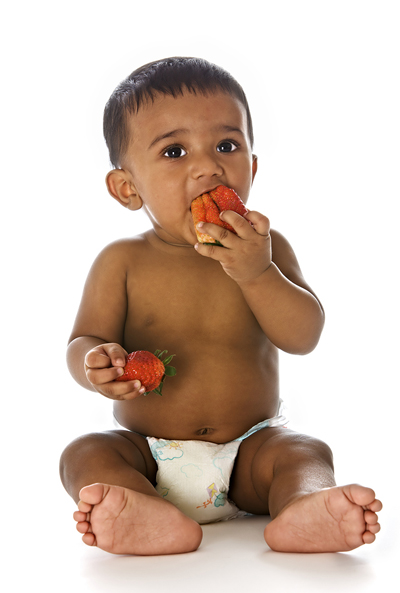All About Starting Solid Foods
Babies start out on breastfeeding or formula milk, however at 4to 6 months a baby needs more of nutrients for his/her development. Solids are necessary to make a baby learn to chew and swallow solid and assist development.
Some tips about starting solid food:
• When you start solid foods your baby should be able to hold his/her head in a steady and upright position and sit well when supported. It helps the baby to swallow.
• Never start your baby on cereal from a bottle, feed him/her with a soft tipped plastic spoon; thickened formula from the bottle could make your baby gag or inhale the liquid into his/her lungs.
• The best time to start solid foods is when your baby stops using the tongue to push out food from the mouth; keeping solid food in his/her mouth and will ultimately help the baby swallow it.
• Start solids when the baby is able to move the food to the back of it mouth and then swallow it; once the baby starts to efficiently swallow the food there would be less drooling.
• A sure indication that a baby should be introduced to solid foods is when the baby seems hungry even after 8 to 10 feedings of breast milk or formula milk.
• Most babies are ready for solid food when their weight is double the weight at birth or about 15 pounds; this is achieved around 4 months of age.
• Most babies are curious about what the parent is eating with time; he/she may reach out for the spoon/fork or bowl. This is the right time to introduce solid foods.

• It is best to start the baby on pureed solid food; any cereal is fine. Some of the best foods are however pureed sweet potatoes, squash, applesauce, bananas, peaches, and pears.
• Start off on solid foods by giving the baby just one or two teaspoons of pureed solid food; a cereal could be mixed with enough formula or breast milk to form a semi liquid consistency. You could gradually thicken the consistency by adding lesser liquid; increase the number of feedings once his/her appetite increases.
• Introduce one food to the baby at one time; wait for a few days before introducing another new food; this will help notice allergies like vomiting, rash or diarrhea. Most of these symptoms appear within 4 hours after eating.
• Most babies may not take to some foods at the very first time and may wince after eating it; some babies take a few times before accepting a new food. It would be advisable to offer the same food after some days mixed with something he/she likes; the baby may take to it.
Take the next step toward your goals
Share your requirement and find the best care providers in your area
-
Looking for a caretaker’s job? Build your profile and get in touch with families in your vicinity.
-
Discover nannies, babysitters, cooks, housekeepers, pet sitters, and elder care under one roof.
-
Get all the support you need to run a successful care center.
-
Search for appropriate centers near you depending on your needs.
Care Corner Insights: Blog Library

Overnight Babysitters in Bellevue, WA for Business-Travelling NRI Parents: Safety & Policies
For many NRI parents living in Bellevue, WA, frequent business trips are a reality. While traveling, one of the biggest concerns is ensuring your children are safe, cared for, and emotionally supported during overnight stays. Overnight babysitters ca

Indian Home-Style Cooks in Queens, NY: Tiffin-Style Weekly Meal Prep from Your Kitchen
Queens, NY, is home to one of the most diverse food cultures in the country, and Indian cuisine holds a special place among families looking for authentic, comforting meals. While restaurant takeout is convenient, nothing compares to the taste and nu

Baby Sleep Problems: What is Sleep Regression and How to Handle It
If you’re a parent, you know that baby sleep is one of the greatest mysteries of life. One day your little one is snoozing like an angel, and the next day they’re suddenly waking up every hour, fussing, or refusing to nap. Before you panic, there’s a

What is Validation Therapy? A New Approach to Dementia Care
Caring for loved ones with dementia is one of the most emotionally challenging journeys a family can face. Traditional methods often focus on correcting memory lapses or redirecting confused thoughts—but that can sometimes lead to frustration, stress

What is a Part-Time Nanny and Do You Need One
Parenting is a beautiful journey, but let’s be honest—it can also be exhausting! Between work deadlines, household chores, and family responsibilities, sometimes there just aren’t enough hours in a day. That’s where part-time nannies step in, offerin

Part-Time Housekeeper Hiring in Alpharetta, GA: Weekly Schedules, Pricing, and Must-Do Tasks
Keeping a home spotless while balancing work, family, and personal commitments can be overwhelming. For families and professionals in Alpharetta, GA, hiring a part-time housekeeper is one of the most practical solutions. Whether you need help once a

Affordable Daycares in Irving, TX with Indian Menu Options: Parent Reviews & Enrollment Tips
Finding the right daycare for your little one is never an easy decision—especially if you’re looking for one that fits your budget and offers familiar food options like an Indian-inspired menu. For parents in Irving, TX, the good news is that several

Can Babies Sleep on Their Side? Tips for Safe Baby Sleep
When it comes to newborns, every parent worries about the smallest details—how they sleep, what they wear, even which way they turn their tiny heads. One common question that pops up is: “Can babies sleep on their side?” The short answer? Not recom

8 Benefits of Hiring a House Cleaner for Your Home
Let’s be honest — keeping a home sparkling clean while juggling work, family, and daily life can feel like a full-time job in itself. That’s where professional house cleaners step in, turning the chaos into calm. If you’ve been debating whether to br

How to Care for a Gassy Baby? What’s Normal and what’s not – Expert Advice
If you’re a new parent navigating the world of burps, bubbles, and baby fussiness—welcome to the club! Gas in babies is incredibly common, especially in the first few months. But how do you know what’s normal and when it’s time to call in expert help